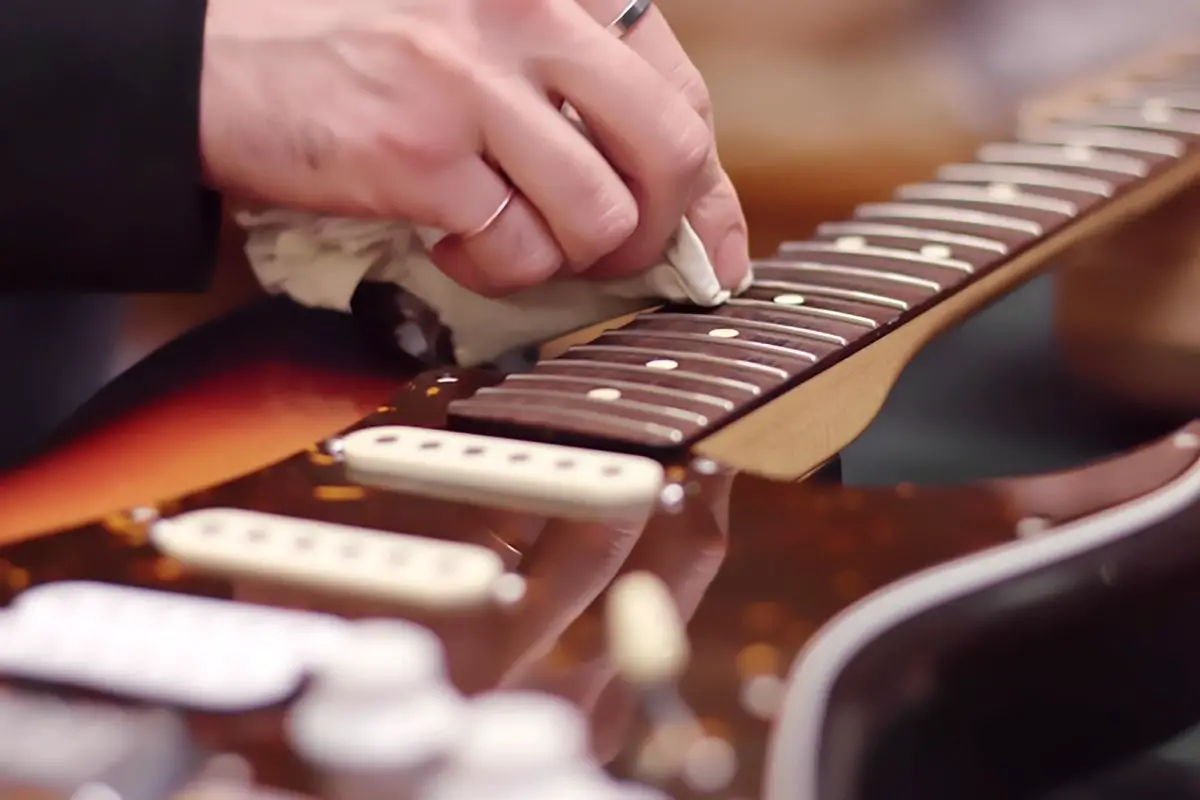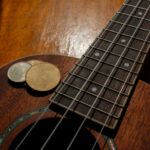As a guitarist, one concern that might cross your mind is whether guitar strings can cut your fingers. While it’s relatively rare for this to happen during normal play, there are a few situations where you might be at risk for finger injuries.
The sharp ends of strings near the tuning pegs can poke or cut you if you’re not careful, and if a string snaps mid-play with enough force, it could potentially cause a cut as well. However, with proper technique, maintenance, and mindfulness, these injuries can be avoided.
Understanding the potential dangers associated with guitar strings can spare you the pain and discomfort of finger injuries. Both electric and acoustic guitars have their own unique characteristics, and being aware of how different string materials, gauges, and tensions can impact your playing experience is crucial.
With this knowledge, you can choose the right string type and make adjustments accordingly to minimize any risks. Practicing good technique is essential not only for improving your guitar playing skills but also for preventing injuries.
It’s common for beginners to unintentionally apply excessive pressure or use improper sliding and bending techniques, increasing the likelihood of sustaining injuries such as cuts, calluses, or discomfort. As you gain experience and skill, you’ll naturally develop a lighter touch, thereby reducing the risk of injury.
Key Takeaways on Can Guitar Strings Cut Your Fingers?
- It’s possible for guitar strings to cut your fingers, but proper technique and mindfulness can help avoid injuries.
- Different string types, gauges, and materials can impact the risk of injury, so choosing the right strings for your needs is essential.
- Developing good playing habits, maintaining your guitar, and using protective tools can significantly reduce the risk of finger injuries while playing.
Check out these other top posts:
- Can Electric Guitars Be Wireless?
- Why Does My Guitar Sound Bad?
- What You Need to Play Electric Guitar
Understanding Guitar Strings and Their Potential Dangers
As a guitarist, I believe it is essential to understand the components of our instrument, particularly the guitar strings. Guitar strings can be made from various materials, such as steel, nylon, and even animal gut.
Steel strings are commonly used in electric and acoustic guitars and are known for their bright, clear sound. However, with the advantages of steel strings, there also come potential dangers that one should be aware of when handling them.
When playing the guitar, it’s crucial to know the risks of potential injuries that can occur from mishandling metal strings. One of the most common issues is the sharp ends of the strings, which can easily cut into your skin if not trimmed properly. Old or poorly maintained strings can also have frayed ends that can catch on to your fingers while playing, posing an injury risk.
In addition to sharp string ends, old and worn-out strings are more likely to break during use. A sudden broken string can cause cuts or other injuries, especially when playing with more force.
Moreover, the tension of steel strings can sometimes cause discomfort or even cuts when pressing down on the frets for an extended period, particularly for beginners who have yet to develop calluses on their fingertips.
To minimize the risk of injury from metal guitar strings, always ensure that your strings are well-maintained and clean. Regularly inspecting the strings for signs of wear or damage can help prevent accidents while playing.
If any strings appear to be worn or frayed, it’s best to replace them with new ones. When changing strings, it’s crucial to trim any excess string ends to avoid any sharp or dangerous protrusions.
While steel guitar strings come with potential dangers and risks of injury, taking proper care and precautions can ensure a safe and enjoyable playing experience. With diligence in maintenance, playing techniques, and instrument care, you can confidently play your steel string guitar without fear of cuts or injuries.
Finger Injuries from Guitar Playing
As a guitar player, I’ve encountered various degrees of finger-related pain and discomfort. Although it’s possible for guitar strings to cut your fingers, the chances are quite low if you handle your instrument correctly. Nevertheless, injuries can still occur, which is why I want to cover some of the potential problems and how to minimize the risk.
When playing the guitar, our fingertips often experience the most strain. Bending or pressing a string can put enough pressure on the fingertip to potentially cause it to separate from the fingernail. While this isn’t exactly a cut, it can be quite painful.
In such cases, the best course of action is to let the injured finger rest and, if needed, apply a bandage or tape to relieve some pressure.
The initial stages of learning guitar usually involve sore fingers because the fingertips are still soft and not accustomed to the constant plucking of strings. Over time, the fingertips become hardened, and the pain or pressure from string plucking and sliding will reduce. Be extra cautious when sliding your fingers on the 5th and 6th strings, as they tend to have higher tension and can cause more discomfort.
When playing, pay attention to the strings’ sharpness, especially on the first, second, and third ones. These strings have fewer windings and can be sharper than the rest. Learning how to handle your guitar carefully and efficiently will help avoid any finger cuts or injuries.
Maintaining good hand hygiene and avoiding any contact with objects that may cause additional injury is essential. Make sure you have clean and well-maintained fingernails, as well as clean hands before playing the guitar. This can help prevent potential infections and aid in quicker recovery if a minor cut or injury does occur.
My advice in protecting your fingers while playing the guitar is to build calluses gradually, practice proper playing techniques, and always be mindful when handling your instrument. This will minimize the risk of finger injuries and help you play with more confidence and comfort.
Techniques to Prevent Injury
When it comes to preventing injuries while playing the guitar, a few techniques and precautions can go a long way. By focusing on your control and posture, you can significantly reduce the risk of injuring your fingers. Here are some helpful tips that have worked for me.
First and foremost, make sure to maintain a good posture and hand positioning while playing the guitar. By keeping your hands and fingers in a relaxed and comfortable position, you can avoid unnecessary stress and strain on the fingers. This in turn helps avoid accidents caused by excessive tension or uneven pressure distribution.
One technique that’s greatly beneficial is being mindful of the amount of pressure you apply on the strings. Excessive pressure can lead to discomfort and can increase the risk of cutting your fingers. It is essential to find the right balance of pressure and control to play efficiently without risking injury.
While practicing, focus on mastering the correct finger placement on the fretboard. Placing fingers close to the frets help avoid the need to apply excessive pressure and maintain a more comfortable playing experience. Proper finger placement also provides better control, which helps to prevent accidents.
When it comes to choosing guitar strings, using lighter-gauge strings can make a difference in avoiding injury. Lighter strings are easier to press down and cause less strain on fingers. Additionally, they tend to produce a softer sound, which can be useful in certain musical styles.
Another way to protect the fingers is by using a guitar pick when playing. This simple tool helps to avoid direct contact between my fingers and the sharp metal strings. A pick also provides better control and precision when picking or strumming the strings.
In conclusion, by focusing on proper technique, control, finger placement, and utilizing accessories like lighter-gauge strings or a guitar pick, guitarists can minimize the risk of injury while playing the guitar. Adopting these practices will allow you to enjoy guitar sessions without the fear of getting fingers cut by the strings.
Maintaining and Changing Strings Regularly
It’s crucial to maintain and change guitar strings regularly for various reasons. First, worn-out strings may lead to inconsistent tuning and lackluster sound quality, which can be frustrating during practice and performances. Furthermore, old strings have a higher chance of snapping while playing, and this could potentially cause injury due to the sharp ends or the tension released.
To maintain the optimal performance of my guitar, regularly wipe down the strings after each playing session. This removes any dirt, sweat, and oils that can cause corrosion, leading to weakened strings. Additionally, store your guitar in a case or use a string cover to protect the strings from dust and environmental factors.
Changing guitar strings varies depending on factors such as the frequency of playing, the type and brand of strings, and personal preferences. A general guideline is to change strings every 3-4 months or when you notice a decline in sound quality, tuning issues, or visible signs of wear and tear.
When changing strings, be cautious and take your time, especially around the tuning pegs. The sharp ends near the tuning pegs can easily poke or cut fingers if mishandled. To prevent injuries, use wire cutters to trim the ends or fold them in a way that reduces the likelihood of accidents.
Special Characteristics of String Types
Different types of guitar strings have unique characteristics that can affect the possibility of getting cuts on your fingers. Let me share some insights on various string types and their special features.
Guitar strings come in different materials, with nylon and steel being the most common. Nylon strings are typically used on classical guitars and are known for their warm, mellow tone. Due to their softer nature, nylon strings are gentler on the fingers and are less likely to cause cuts or discomfort during play.
On the other hand, steel strings are commonly used for acoustic and electric guitars. These strings produce a brighter and louder sound but can be tougher on your fingers. The thinner, lighter-gauge strings, such as the high E and B strings, tend to cause more finger discomfort than the thicker strings.
Guitarists should be careful when playing these strings, as they can potentially cut your fingers if not handled properly.
Another option you might consider is coated strings. These strings have a thin layer of polymer coating that not only extends the strings’ lifespan but also offers a smoother playing experience. Coated strings can help reduce the risk of cuts on your fingers while providing a comfortable grip for extended playing sessions.
Choosing the right gauge for your guitar strings is always essential, as this determines their tension and thickness. Lighter-gauge strings are easier to play and bend, but they can also cause more friction on your fingertips, potentially leading to cuts.
On the other hand, heavier-gauge strings are harder to bend but provide more stability and are usually less likely to cause finger injuries.
As a guitarist, I understand the importance of choosing the right strings to match your playing style and preferences. Balancing comfort with sound quality should be a priority when considering the variety of string materials, gauges, and coatings available. Remember, proper technique and hand positioning can also help minimize the risk of injury when playing guitar.
Tools to Protect Your Fingers and Improve Technique
As a guitarist, I understand that playing guitar can sometimes be rough on the fingers. It’s crucial to take care of our hands while we build better technique and develop callouses to protect our fingers.
In this section, I’ll share some useful equipment and tips that can help with protecting our fingers and improving our guitar playing technique.
Firstly, using a guitar pick can be an excellent way to reduce direct contact between the strings and the fingertips. Guitar picks can provide precision and control when picking or strumming the strings, allowing guitarists to avoid potential damage to our fingers. There are various shapes, sizes, and materials available, so it’s essential to experiment and find the perfect pick that suits our playing style.
Another option is to wear protective gloves specifically designed for playing guitar. These gloves can provide a protective barrier between our fingers and the guitar strings. Some guitarists find that gloves also help improve their grip on the instrument.
However, it’s important to understand that gloves might not be suitable for every guitarist, as they can limit the sensation and dexterity of our fingers on the fretboard.
One of the best ways to protect our fingers and become more comfortable with guitar playing is to develop calluses on our fingertips. Callouses form as a response to pressure and friction on our fingers while playing the guitar.
Over time, these natural protectors will help us play for extended periods without experiencing pain or soreness. To speed up the process of forming calluses, I recommend practicing consistently and allowing our fingertips to rest and heal whenever they feel excessively sore.
Lastly, focusing on overall technique can play a significant role in protecting our fingers and improving our guitar playing. A proper grip on the neck, accurate finger placement on the frets, and using the appropriate amount of pressure can make a world of difference in our playing experience.
By being mindful of our technique and practicing regularly, we can gradually become more efficient and confident guitarists without harming our fingers.
Dealing with Finger Injuries
From my experience and research, I can say that while guitar strings can cause minor cuts, they are not usually severe. However, if you do experience a finger cut or injury when playing the guitar, it’s essential to know how to deal with it effectively.
First and foremost, when you have a cut or injury, stop playing immediately and assess the situation. If the wound is bleeding, apply pressure using a clean cloth or tissue to help stop the bleeding. It is crucial not to panic and to stay calm during the process.
Once the bleeding has stopped, clean the wound gently with water and mild soap to prevent infection. Avoid using alcohol or hydrogen peroxide as they might be too harsh on the injured area. After cleaning the cut, apply a topical antibiotic ointment to further minimize the risk of infection.
Next, protect the wound by covering it with a clean bandage. Be sure to change the bandage daily and to keep the wound clean and dry. If you notice any signs of infection, like redness, swelling, or increased pain, consult a healthcare professional immediately.
Lastly, rest is crucial. Give your injured finger some time to heal before returning to play the guitar. Practicing self-care and patience can be challenging, but it’s essential to enable a full and speedy recovery.
Remember, it’s crucial to listen to your body and take care of any finger injuries before they become a more significant issue. Moreover, don’t forget to use the proper techniques when playing the guitar to minimize the risk of injury.
Less-Known Factors Contributing to Finger Cuts
Though it’s relatively rare for guitar strings to cut your fingers during normal playing, there are a few lesser-known factors that can contribute to this occurrence. One such factor is the presence of sharp frets on the guitar neck. In this situation, when you slide a fingers across the frets, there’s a chance that fingers might get caught and cut.
Another factor to consider is the force that you tap or strum the strings. If you apply too much force, it might lead to a higher chance of cuts and abrasions on the fingers. Similarly, while executing bends, ensure you apply minimal pressure on the strings.
String snapping is another aspect that can lead to finger cuts while playing the guitar. Old or corroded strings are more likely to snap, which can cause sharp ends to whip out and potentially hurt your fingers. To avoid this, it’s essential to inspect guitar strings regularly and replace them when necessary.
Frequently Asked Questions
Can frequent guitar playing lead to finger injuries?
Yes, frequent guitar playing can lead to finger injuries, especially when practicing for extended periods. More hand movements, plucking, and fretting can cause bruising or even bleeding on your fingers. However, with proper technique and care, most of these injuries can be prevented.
How can one avoid finger cuts while playing guitar?
To avoid finger cuts while playing the guitar, make sure to handle the strings properly. Ensure your guitar is well-maintained and doesn’t have sharp frets or hardware.
If the strings snap during play, they can potentially cause injury. Regularly trimming the excess strings protruding from the tuning pegs also helps in preventing accidental pokes and cuts.
Are certain guitar strings more likely to cause finger pain?
Different types of guitar strings can cause varying levels of finger pain. For instance, steel strings found on acoustic and electric guitars can be tougher on fingers compared to the nylon strings of classical guitars. Beginners might find lighter gauge strings to be more comfortable to play until they develop calluses.
What measures can be taken to protect fingers from guitar strings?
To protect your fingers from guitar strings, ensure that you use proper technique and hand positioning while playing.
You can also give your fingers a break between practice sessions to allow them time to recover. Some guitarists use finger protectors or apply medical tape to sore areas of their fingertips to provide an extra layer of protection.
Is it normal for fingers to bleed when playing guitar?
While it is not common, it’s possible for fingers to bleed when playing guitar, especially if you’re a beginner or playing aggressively.
After teaching for a long time now, I have yet to see an occurrence of fingers bleeding while playing or learning to play.
There is no question your fingers will hurt, sometimes after playing has finished you might feel them sore – this is natural and usually goes away after a while.
If you notice bleeding, stop playing and clean the wound before continuing your practice. Over time, the development of calluses will help prevent your fingers from bleeding in the future.
How long does it take to develop calluses for playing guitar?
The development of calluses varies for each individual, but generally, it can take several weeks to a few months of regular practice to form calluses.
These hardened layers of skin on your fingertips will help you play guitar more comfortably and reduce the chance of injury. Remember to be patient and consistent in your practice routine for the best results.
You might notice when you start to play lead guitar that given you will be bending strings that your fingers may be more sore than usual – this is totally normal.
As with general chord playing and holding down notes, your fingers will get used to this.
If the pain persists consider trying lighter strings i.e. no more than gauge 10 (Top E string) this will ease the pain on those bends.








